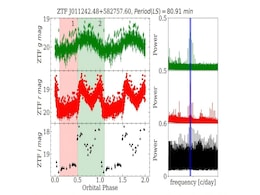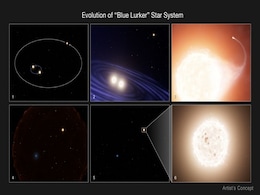Dwarf Star
- All
- News
-

Astronomers Detect Methane in the Atmosphere of the Nearest T Dwarf Star to Earth
- Saturday April 12, 2025
- Written by Gadgets 360 Staff
Astronomers have detected methane in the nearest known T dwarf, offering new insight into its atmospheric composition. The study further highlights that the carbon abundance in the planet is estimated to be -1.5 dex, while the effective temperature could be around 1,000 K. The author of the paper further revealed that the low metallicity of the T ...
-
 www.gadgets360.com
www.gadgets360.com
-

First Future Type 1a Supernova Detected: White Dwarf Pair to Collide in 23 Billion Years
- Tuesday April 8, 2025
- Written by Gadgets 360 Staff
Astronomers have discovered a pair of white dwarf stars located about 150 light-years from Earth that are on course to collide and produce a Type 1a supernova in approximately 23 billion years. This is the first such system identified near our region of the galaxy. With a combined mass of 1.56 solar masses, the stars are slowly spiralling toward ea...
-
 www.gadgets360.com
www.gadgets360.com
-

T Corona Borealis May Erupt Soon: Rare Nova Could Be Visible to Naked Eye
- Tuesday April 1, 2025
- Written by Gadgets 360 Staff
T Corona Borealis, a binary star system in the Northern Crown constellation, is showing signs of an imminent nova eruption. The white dwarf star, which pulls material from its red giant companion, last erupted in 1946. Astronomers have detected patterns similar to previous eruptions, leading to predictions of a possible outburst within the next two...
-
 www.gadgets360.com
www.gadgets360.com
-

Andrew Burnap On Being Cast In Rachel Zegler And Gal Gadot's Snow White: "My Life Is Really Going To Change"
- Sunday March 23, 2025
- Entertainment | Asian News International
Andrew Burnap shared his experience on being starred in Snow White and the Seven Dwarfs
-
 www.ndtv.com/entertainment
www.ndtv.com/entertainment
-

Smallest Galaxy Ever Found: Andromeda XXXV Defies Cosmic Evolution Models
- Thursday March 13, 2025
- Written by Gadgets 360 Staff
Astronomers have discovered Andromeda XXXV, the smallest and faintest known galaxy, located 3 million light-years away. It challenges existing models of galaxy formation, as similar small galaxies were thought to be destroyed in the early universe. Researchers are studying how it retained conditions for star formation despite harsh cosmic environme...
-
 www.gadgets360.com
www.gadgets360.com
-

New Polar Cataclysmic Variable Identified by Astronomers: What You Need to Know
- Friday March 7, 2025
- Written by Gadgets 360 Staff
Astronomers have detected ZTF J0112+5827, a newly identified polar cataclysmic variable. This binary system, composed of a white dwarf and a low-mass donor star, features an 80.9-minute orbital period and a strong magnetic field of 38.7 MG. It lacks an accretion disk, with emissions mainly from its accretion stream and magnetic field lines. The sys...
-
 www.gadgets360.com
www.gadgets360.com
-

X-ray Signal from Helix Nebula Suggests Planet Was Destroyed by White Dwarf
- Thursday March 6, 2025
- Written by Gadgets 360 Staff
Astronomers have traced decades-old X-ray emissions from the Helix Nebula to a white dwarf possibly consuming planetary debris. Reports suggest a Jupiter-like planet may have been torn apart by the star’s intense gravitational forces. Data from NASA’s Chandra X-ray Observatory and ESA’s XMM-Newton indicate that remnants of the destroyed plane...
-
 www.gadgets360.com
www.gadgets360.com
-

James Webb Space Telescope Observes Mysterious Rogue Planet-Like Object
- Thursday March 6, 2025
- Written by Gadgets 360 Staff
The James Webb Space Telescope has captured new insights into SIMP 0136, a planetary-mass object floating freely around 20 light-years away. This celestial body, possibly a rogue planet or a brown dwarf, has puzzled astronomers for years. JWST’s infrared observations have revealed intricate cloud layers, temperature shifts, and potential chemical...
-
 www.gadgets360.com
www.gadgets360.com
-

Strange Fast Radio Bursts Emerge from an Ancient Dead Galaxy, Baffling Scientists
- Monday February 24, 2025
- Written by Gadgets 360 Staff
Scientists have detected mysterious fast radio bursts (FRBs) from the outskirts of an 11 billion-year-old dead galaxy. This discovery challenges the belief that FRBs primarily originate from young, star-forming galaxies. Researchers suspect the bursts may result from colliding stars or a collapsing white dwarf. The Canadian Hydrogen Intensity Mappi...
-
 www.gadgets360.com
www.gadgets360.com
-

Vera C. Rubin Observatory to Detect Millions of Exploding Stars
- Wednesday January 29, 2025
- Written by Gadgets 360 Staff
The Vera C. Rubin Observatory, set to begin its 10-year Legacy Survey of Space and Time (LSST) later this year, will track millions of Type Ia supernovae to advance our understanding of dark energy. These supernovae, resulting from white dwarf stars in binary systems, will be studied in detail to provide crucial data on the universe’s acceleratin...
-
 www.gadgets360.com
www.gadgets360.com
-

Astronomers Observe Black Hole Reactivate, Emitting Jets of Plasma
- Monday January 20, 2025
- Written by Gadgets 360 Staff
A supermassive black hole at the center of galaxy 1ES 1927+654 has been observed reactivating after a quiet period. Jets of hot gas were released from both sides of the black hole, surprising astronomers. Researchers speculate that a white dwarf star in close orbit may be interacting with the black hole, providing key insights into cosmic behavior....
-
 www.gadgets360.com
www.gadgets360.com
-

Webb Telescope Tracks Formation and Expansion of Carbon-Rich Dust Shells in Star System
- Thursday January 16, 2025
- Written by Gadgets 360 Staff
As per the latest report by NASA, the system consists of two stars in an elongated orbit. When these stars come closest, their stellar winds collide, compressing material and forming carbon-rich dust. As reported in an official press release by NASA, Emma Lieb, a doctoral student at the University of Denver and the study's lead author, noted that t...
-
 www.gadgets360.com
www.gadgets360.com
-

NASA’s Hubble Observes Rare Blue Lurker Star with Unusual Evolution in M67 Cluster
- Friday January 17, 2025
- Written by Gadgets 360 Staff
NASA’s Hubble Space Telescope has identified a rare stellar phenomenon called the “blue lurker” in the M67 star cluster. Located 2,800 light-years away, this star is part of a triple-star system and has an unusual evolutionary history. The blue lurker’s accelerated spin, taking just four days, contrasts with the typical rotation of Sun-like...
-
 www.gadgets360.com
www.gadgets360.com
-

White Dwarf’s Unexplainable Rapid Spin Finally Decoded by Scientists
- Tuesday January 14, 2025
- Written by Gadgets 360 Staff
The white dwarf star RX J0648.0–4418, 1,700 light-years away, spins at a rapid pace of 13 seconds per rotation. Part of a binary system with a helium-burning hot subdwarf star, it continues to shrink while accreting material. This rare and short-lived system provides a unique view into stellar evolution. Approaching the Chandrasekhar limit, RX J0...
-
 www.gadgets360.com
www.gadgets360.com
-

Five Dwarf Galaxies Found in a Rare Alignment, Challenges Current Cosmic Models
- Saturday January 4, 2025
- Written by Gadgets 360 Staff
A rare alignment of five dwarf galaxies, positioned around 117 million light-years away, has been discovered by astronomers. This grouping, which challenges existing models of galaxy formation, shows active star formation despite their small sizes. The galaxies, labelled D1 to D5, exhibit unique characteristics, including shared rotational motion a...
-
 www.gadgets360.com
www.gadgets360.com
-

Astronomers Detect Methane in the Atmosphere of the Nearest T Dwarf Star to Earth
- Saturday April 12, 2025
- Written by Gadgets 360 Staff
Astronomers have detected methane in the nearest known T dwarf, offering new insight into its atmospheric composition. The study further highlights that the carbon abundance in the planet is estimated to be -1.5 dex, while the effective temperature could be around 1,000 K. The author of the paper further revealed that the low metallicity of the T ...
-
 www.gadgets360.com
www.gadgets360.com
-

First Future Type 1a Supernova Detected: White Dwarf Pair to Collide in 23 Billion Years
- Tuesday April 8, 2025
- Written by Gadgets 360 Staff
Astronomers have discovered a pair of white dwarf stars located about 150 light-years from Earth that are on course to collide and produce a Type 1a supernova in approximately 23 billion years. This is the first such system identified near our region of the galaxy. With a combined mass of 1.56 solar masses, the stars are slowly spiralling toward ea...
-
 www.gadgets360.com
www.gadgets360.com
-

T Corona Borealis May Erupt Soon: Rare Nova Could Be Visible to Naked Eye
- Tuesday April 1, 2025
- Written by Gadgets 360 Staff
T Corona Borealis, a binary star system in the Northern Crown constellation, is showing signs of an imminent nova eruption. The white dwarf star, which pulls material from its red giant companion, last erupted in 1946. Astronomers have detected patterns similar to previous eruptions, leading to predictions of a possible outburst within the next two...
-
 www.gadgets360.com
www.gadgets360.com
-

Andrew Burnap On Being Cast In Rachel Zegler And Gal Gadot's Snow White: "My Life Is Really Going To Change"
- Sunday March 23, 2025
- Entertainment | Asian News International
Andrew Burnap shared his experience on being starred in Snow White and the Seven Dwarfs
-
 www.ndtv.com/entertainment
www.ndtv.com/entertainment
-

Smallest Galaxy Ever Found: Andromeda XXXV Defies Cosmic Evolution Models
- Thursday March 13, 2025
- Written by Gadgets 360 Staff
Astronomers have discovered Andromeda XXXV, the smallest and faintest known galaxy, located 3 million light-years away. It challenges existing models of galaxy formation, as similar small galaxies were thought to be destroyed in the early universe. Researchers are studying how it retained conditions for star formation despite harsh cosmic environme...
-
 www.gadgets360.com
www.gadgets360.com
-

New Polar Cataclysmic Variable Identified by Astronomers: What You Need to Know
- Friday March 7, 2025
- Written by Gadgets 360 Staff
Astronomers have detected ZTF J0112+5827, a newly identified polar cataclysmic variable. This binary system, composed of a white dwarf and a low-mass donor star, features an 80.9-minute orbital period and a strong magnetic field of 38.7 MG. It lacks an accretion disk, with emissions mainly from its accretion stream and magnetic field lines. The sys...
-
 www.gadgets360.com
www.gadgets360.com
-

X-ray Signal from Helix Nebula Suggests Planet Was Destroyed by White Dwarf
- Thursday March 6, 2025
- Written by Gadgets 360 Staff
Astronomers have traced decades-old X-ray emissions from the Helix Nebula to a white dwarf possibly consuming planetary debris. Reports suggest a Jupiter-like planet may have been torn apart by the star’s intense gravitational forces. Data from NASA’s Chandra X-ray Observatory and ESA’s XMM-Newton indicate that remnants of the destroyed plane...
-
 www.gadgets360.com
www.gadgets360.com
-

James Webb Space Telescope Observes Mysterious Rogue Planet-Like Object
- Thursday March 6, 2025
- Written by Gadgets 360 Staff
The James Webb Space Telescope has captured new insights into SIMP 0136, a planetary-mass object floating freely around 20 light-years away. This celestial body, possibly a rogue planet or a brown dwarf, has puzzled astronomers for years. JWST’s infrared observations have revealed intricate cloud layers, temperature shifts, and potential chemical...
-
 www.gadgets360.com
www.gadgets360.com
-

Strange Fast Radio Bursts Emerge from an Ancient Dead Galaxy, Baffling Scientists
- Monday February 24, 2025
- Written by Gadgets 360 Staff
Scientists have detected mysterious fast radio bursts (FRBs) from the outskirts of an 11 billion-year-old dead galaxy. This discovery challenges the belief that FRBs primarily originate from young, star-forming galaxies. Researchers suspect the bursts may result from colliding stars or a collapsing white dwarf. The Canadian Hydrogen Intensity Mappi...
-
 www.gadgets360.com
www.gadgets360.com
-

Vera C. Rubin Observatory to Detect Millions of Exploding Stars
- Wednesday January 29, 2025
- Written by Gadgets 360 Staff
The Vera C. Rubin Observatory, set to begin its 10-year Legacy Survey of Space and Time (LSST) later this year, will track millions of Type Ia supernovae to advance our understanding of dark energy. These supernovae, resulting from white dwarf stars in binary systems, will be studied in detail to provide crucial data on the universe’s acceleratin...
-
 www.gadgets360.com
www.gadgets360.com
-

Astronomers Observe Black Hole Reactivate, Emitting Jets of Plasma
- Monday January 20, 2025
- Written by Gadgets 360 Staff
A supermassive black hole at the center of galaxy 1ES 1927+654 has been observed reactivating after a quiet period. Jets of hot gas were released from both sides of the black hole, surprising astronomers. Researchers speculate that a white dwarf star in close orbit may be interacting with the black hole, providing key insights into cosmic behavior....
-
 www.gadgets360.com
www.gadgets360.com
-

Webb Telescope Tracks Formation and Expansion of Carbon-Rich Dust Shells in Star System
- Thursday January 16, 2025
- Written by Gadgets 360 Staff
As per the latest report by NASA, the system consists of two stars in an elongated orbit. When these stars come closest, their stellar winds collide, compressing material and forming carbon-rich dust. As reported in an official press release by NASA, Emma Lieb, a doctoral student at the University of Denver and the study's lead author, noted that t...
-
 www.gadgets360.com
www.gadgets360.com
-

NASA’s Hubble Observes Rare Blue Lurker Star with Unusual Evolution in M67 Cluster
- Friday January 17, 2025
- Written by Gadgets 360 Staff
NASA’s Hubble Space Telescope has identified a rare stellar phenomenon called the “blue lurker” in the M67 star cluster. Located 2,800 light-years away, this star is part of a triple-star system and has an unusual evolutionary history. The blue lurker’s accelerated spin, taking just four days, contrasts with the typical rotation of Sun-like...
-
 www.gadgets360.com
www.gadgets360.com
-

White Dwarf’s Unexplainable Rapid Spin Finally Decoded by Scientists
- Tuesday January 14, 2025
- Written by Gadgets 360 Staff
The white dwarf star RX J0648.0–4418, 1,700 light-years away, spins at a rapid pace of 13 seconds per rotation. Part of a binary system with a helium-burning hot subdwarf star, it continues to shrink while accreting material. This rare and short-lived system provides a unique view into stellar evolution. Approaching the Chandrasekhar limit, RX J0...
-
 www.gadgets360.com
www.gadgets360.com
-

Five Dwarf Galaxies Found in a Rare Alignment, Challenges Current Cosmic Models
- Saturday January 4, 2025
- Written by Gadgets 360 Staff
A rare alignment of five dwarf galaxies, positioned around 117 million light-years away, has been discovered by astronomers. This grouping, which challenges existing models of galaxy formation, shows active star formation despite their small sizes. The galaxies, labelled D1 to D5, exhibit unique characteristics, including shared rotational motion a...
-
 www.gadgets360.com
www.gadgets360.com
















